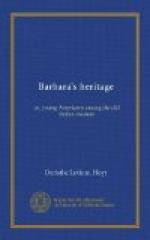All were eager to see whatever there was of interest. As it would be best to wait until morning for looking at the pictures, they at once set forth and walked along the narrow streets lined with arcades, and through grassy Il Prato, with its fourscore and more statues of Padua’s famous men ranged between the trees. They saw the traditional house of Petrarch, and that of Dante, in front of which stands a large mediaeval sarcophagus reported to contain the bones of King Antenor, who, according to the poet Virgil, founded the city. They admired the churches, from several of which clusters of Byzantine domes rise grandly against the sky, noted the order, the quiet, that now reigns throughout the streets, and talked of the fierce, horrible warfare that had centuries ago raged there.
The next morning they spent among Giotto’s frescoes, over thirty of which literally cover the walls of the Arena Chapel. The return to the work of the early fourteenth century, after months spent in study of the High Renaissance, was like an exchange of blazing noon sunshine for the first soft, sweet light that heralds the coming dawn. They were surprised at the freshness and purity of color and at the truth and force of expression. They had forgotten that old Giotto could paint so well. They found it easy now to understand in the artist that which at first had been difficult.
“Do you not think that Dante sometimes came here and sat while Giotto was painting?” by and by asked Margery, in an almost reverent voice.
“I do not doubt it,” replied Mrs. Douglas. “Tradition tells us that they were great friends, and that when here together in Padua they lived in the same house. I always think of Giotto as possessing a jovial temperament, and as being full of bright thoughts. He must have been a great comfort to the poor unhappy poet. Without doubt they often walked together to this chapel; and while Giotto was upon the scaffolding, busy with his Bible stories, Dante would sit here, brooding over his misfortunes; or, perhaps, weaving some of his great thoughts into sublime poetry.”
Afterward they went to the Eremitani to see Mantegna’s frescoes, and thought they could see in the noble work of this old Paduan master what Giotto might have done had he lived a century or more later.
Mr. Sumner, however, said that he was sure that Giotto, with his temperament, could never have wrought detail with such exactness and refinement as did Mantegna—but also, that Giotto’s color would always have been far better than Mantegna’s. The likeness between the two artists is the intense desire of each to render expression of thought and feeling.
The following day, on their way from Padua to Milan, they were so fortunate as to be all in the same compartment, and as their train rushed on, their conversation turned upon Leonardo da Vinci, whose works in Milan they were longing to see.
During their stay in Florence they had read much about this great artist, and Mr. Sumner now suggested that each tell something he had learned concerning him.




